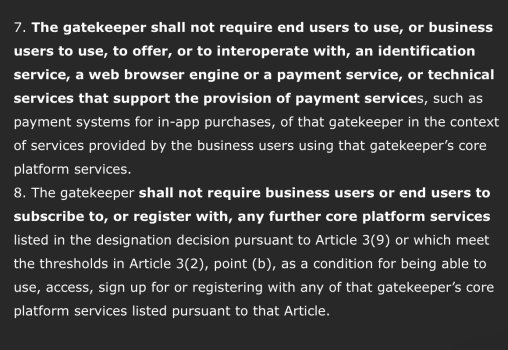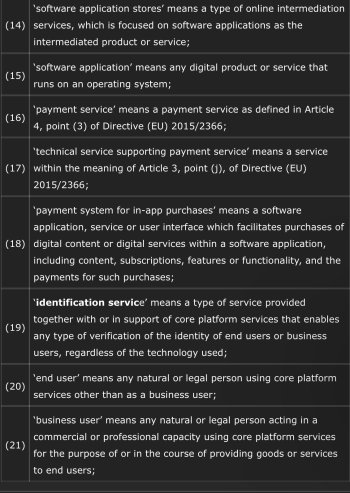iOS developers aren’t just paying a developers fee, but a commission on sales in their digital store front and associated functionality they provide.You're begging the question. iOS developers aren't paying for a store. They're paying a licensing fee for use of iOS and associated services that is collected as a commission on sales subject to specific terms.
They aren’t paying a fee to access iOS, but for the certification of their apps.
To turn it around, why does the Steam store charge so much when all they provide is a storefront?
That is quite the assumption, they provide a lot more than a store front, and the matter is the tremendous value the functionality valve provides is sufficiently valuable for them to take such premium. Apple on the other hand isn’t. The Mac AppStore is only a year younger than steam on Mac.
| 3rd Party Keys | ✅ | ⛔️ | Developers can use 3rd party keys to sell their games on other platforms, offer promotions, reward backers, and more. Valve takes 0% | Apple does not have that feature. All sales take 15-30% |
| SDK | ✅ | ⚠️very limited |
| developer tools | ✅ | ⚠️limited |
| Game engine | ✅ | ⛔️ |
Here you can read the details of the list
SDK ✅Valve’s SDK is the Source SDK, which is a software development kit that allows developers to create mods and custom content for Source-based games. The Source SDK includes the Source engine, the Valve Hammer Editor, FacePoser, model and texture tools, and documentation. The Source SDK also supports Steamworks, a set of APIs and tools that enable developers to integrate Steam features such as achievements, leaderboards, matchmaking, cloud, and more into their games. ⚠️Apple’s SDK is the iOS SDK, which is a software development kit that allows developers to create apps and games for iOS devices. The iOS SDK includes the Xcode IDE, the Swift programming language, the Cocoa Touch framework, the iOS Simulator, and documentation. The iOS SDK also supports various Apple services and technologies, such as App Store Connect, TestFlight, App Store Review Guidelines, App Clips, ARKit, Core ML, SiriKit, and more. developer tools ✅Valve provides a comprehensive set of tools and technologies to create state-of-the-art games with the Source engine, including the Valve Hammer Editor, plug-ins for popular 3D art and animation programs, FacePoser, Source Model Viewer, Particle Editor, Material Editor, Commentary Editor, performance monitoring tools, and multiplayer network features4. Valve also offers complete source code for Half-Life 2, Portal, and Team Fortress 2, as well as extensive documentation and community tutorials ⚠️Apple offers a variety of developer tools and technologies to build apps and games for iOS, iPadOS, macOS, tvOS, watchOS, and visionOS, including Xcode, Swift, SwiftUI, SwiftData, Macros, Observation, SwiftUI animations, WidgetKit, interactive widgets, Metal, and more5. Apple also provides sample code, articles, tutorials, API reference, design guidelines, human interface guidelines Game engine ✅Valve’s game engine is Source, which is widely recognized as one of the most flexible, comprehensive, and powerful game development environments available4. Source combines leading-edge character animation, advanced AI, real-world physics, shader-based rendering, and a highly extensible development environment to produce some of the most popular computer and console games4. Source supports HLSL shaders, radiosity lighting, high dynamic range lighting, radiance transfer, dynamic shadows, shadow depth mapping, rim lighting, advanced material rendering, and a full range of special effects6. ⛔️Apple does not have its own game engine,.
There is, Apple cannot require developers to sign any agreement or services to be approved to sell software outside the AppStoreNever said it doesn't. We were discussing whether a specific regulation exists within the DMA. We agreed that it does not.
Especially when we look at their definition of
identification service’ means a type of service provided together with or in support of core platform services that enables any type of verification of the identity of end users or business users, regardless of the technology used
| (57) | If dual roles are used in a manner that prevents alternative service and hardware providers from having access under equal conditions to the same operating system, hardware or software features that are available or used by the gatekeeper in the provision of its own complementary or supporting services or hardware, this could significantly undermine innovation by such alternative providers, as well as choice for end users. The gatekeepers should, therefore, be required to ensure, free of charge, effective interoperability with, and access for the purposes of interoperability to, the same operating system, hardware or software features that are available or used in the provision of its own complementary and supporting services and hardware. Such access can equally be required by software applications related to the relevant services provided together with, or in support of, the core platform service in order to effectively develop and provide functionalities interoperable with those provided by gatekeepers. The aim of the obligations is to allow competing third parties to interconnect through interfaces or similar solutions to the respective features as effectively as the gatekeeper’s own services or hardware. |
More information in the quote below 👇
4. The gatekeeper shall allow and technically enable the installation and effective use of third-party software applications or software application stores using, or interoperating with, its operating system and allow those software applications or software application stores to be accessed by means other than the relevant core platform services of that gatekeeper. The gatekeeper shall, where applicable, not prevent the downloaded third-party software applications or software application stores from prompting end users to decide whether they want to set that downloaded software application or software application store as their default. The gatekeeper shall technically enable end users who decide to set that downloaded software application or software application store as their default to carry out that change easily.
3. The gatekeeper shall not prevent business users from offering the same products or services to end users through third-party online intermediation services or through their own direct online sales channel at prices or conditions that are different from those offered through the online intermediation services of the gatekeeper.
4. The gatekeeper shall allow business users, free of charge, to communicate and promote offers, including under different conditions, to end users acquired via its core platform service or through other channels, and to conclude contracts with those end users, regardless of whether, for that purpose, they use the core platform services of the gatekeeper.
7. The gatekeeper shall not require end users to use, or business users to use, to offer, or to interoperate with, an identification service, a web browser engine or a payment service, or technical services that support the provision of payment services, such as payment systems for in-app purchases, of that gatekeeper in the context of services provided by the business users using that gatekeeper’s core platform services.
8. The gatekeeper shall not require business users or end users to subscribe to, or register with, any further core platform services listed in the designation decision pursuant to Article 3(9) or which meet the thresholds in Article 3(2), point (b), as a condition for being able to use, access, sign up for or registering with any of that gatekeeper’s core platform services listed pursuant to that Article.
Article 2
Definitions
For the purposes of this Regulation, the following definitions apply:
(10) ‘operating system’ means a system software that controls the basic functions of the hardware or software and enables software applications to run on it;
(11) ‘web browser’ means a software application that enables end users to access and interact with web content hosted on servers that are connected to networks such as the Internet, including standalone web browsers as well as web browsers integrated or embedded in software or similar;
(12) ‘virtual assistant’ means a software that can process demands, tasks or questions, including those based on audio, visual, written input, gestures or motions, and that, based on those demands, tasks or questions, provides access to other services or controls connected physical devices;
(13) ‘cloud computing service’ means a cloud computing service as defined in Article 4, point (19), of Directive (EU) 2016/1148 of the European Parliament and of the Council (24);
(14) ‘software application stores’ means a type of online intermediation services, which is focused on software applications as the intermediated product or service;
(15) ‘software application’ means any digital product or service that runs on an operating system;
(16) ‘payment service’ means a payment service as defined in Article 4, point (3) of Directive (EU) 2015/2366;
(17) ‘technical service supporting payment service’ means a service within the meaning of Article 3, point (j), of Directive (EU) 2015/2366;
(18) ‘payment system for in-app purchases’ means a software application, service or user interface which facilitates purchases of digital content or digital services within a software application, including content, subscriptions, features or functionality, and the payments for such purchases;
(19) ‘identification service’ means a type of service provided together with or in support of core platform services that enables any type of verification of the identity of end users or business users, regardless of the technology used;
(20) ‘end user’ means any natural or legal person using core platform services other than as a business user;
(21) ‘business user’ means any natural or legal person acting in a commercial or professional capacity using core platform services for the purpose of or in the course of providing goods or services to end users;





